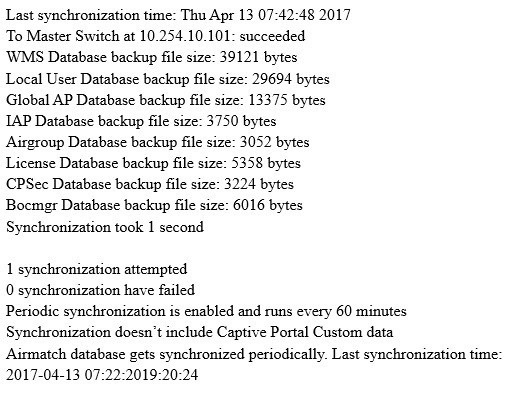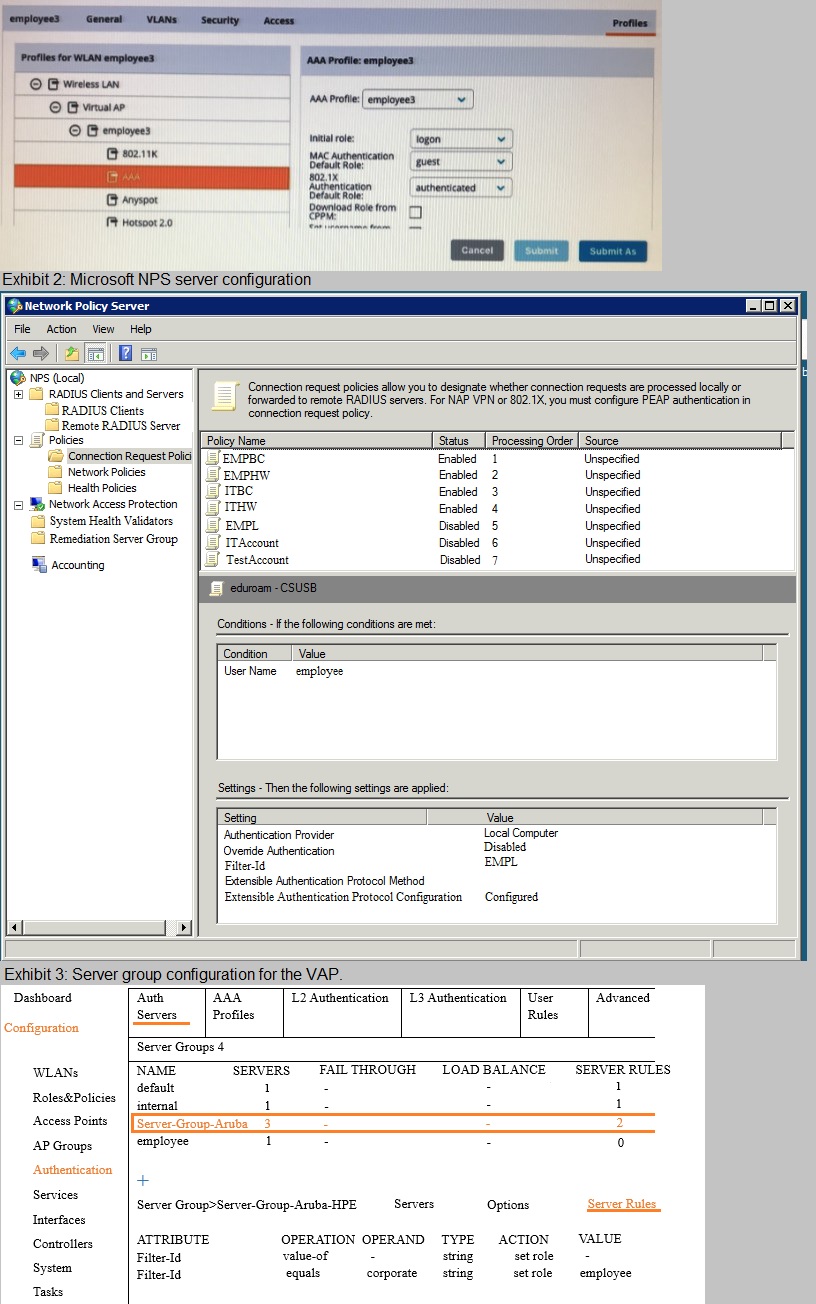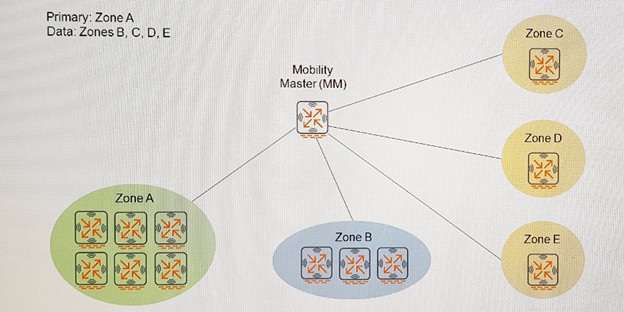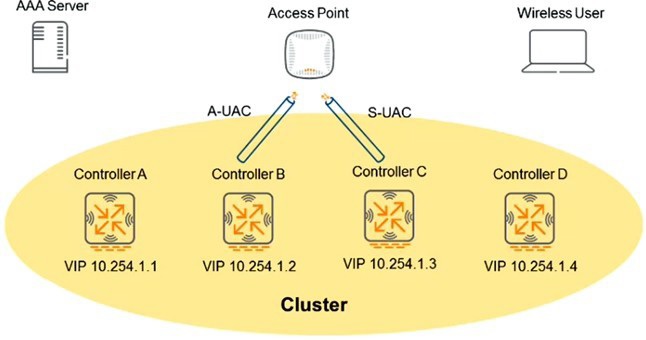An administrator creates service-based policies for AirGroup on the Mobility Master (MM).
The administrator can define location-based policy limits based on which information?
A.
AP names, AP groups, controller names, and controller groups
B.
AP Fully Qualified Location Names (FQLNs) and controller Fully Qualified Domain Names (FQDNs)
C.
AP names, AP groups, and AP Fully Qualified Location Names (FQLNs)
AP names, AP groups, and AP Fully Qualified Location Names (FQLNs)
Refer to the exhibit.
A user uses Microsoft Windows for a wireless session. Based on the output shown in the
exhibit for the selected Aruba AP, what is the possible problem with this user’s wireless
session?
A.
The AP has reached the limit for number of users that are allowed to connect to the radio.
B.
The controller cannot reach the AAA server to perform the authentication.
C.
The user is configured for PEAP, but the WLAN profile on the controller implemented EAP-TLS.
D.
The user misconfigured the Managed Network Settings profile in Windows
The user is configured for PEAP, but the WLAN profile on the controller implemented EAP-TLS.
Refer to the exhibit.
What can be determined from the command output shown in the exhibit?
A.
The synchronized data is protected by VRRP.
B.
The command was executed on the standby Mobility Master (MM).
C.
The synchronization period is at its default value.
D.
The other Mobility Master (MM) is the active license server
The synchronization period is at its default value.
An administrator supports an Aruba wireless solution that uses ClearPass to implement
server role assignment. A user reports that they are not able to access the correct
department resources. The administrator determines from the connected controller that the
user is associated to the login user profile instead of the department user profile.
What should the administrator examine on the ClearPass server to determine the Aruba
VSA User Role value that ClearPass returns to the controller?
A.
Accounting
B.
Event Viewer
C.
Audit Viewer
D.
Access Tracker
Access Tracker
Refer to the exhibits.
Exhibit 1: WLAN VAP configuration
An employee authenticates with the username employee and the correct password.
However, once the user authenticates, an administrator notices that the employee is
assigned the authenticated role and not the desired employee role.
What should the administrator do to solve this problem?
A.
Add a new server group rule on the controller.
B.
Associate the user to the employee group in Microsoft NPS.
C.
Change the server group name on the controller.
D.
Reference the employee role in the WLAN VAP on the controller.
Add a new server group rule on the controller.
Which VPN component must be configured on the Mobility Master (MM) to allow a RAP to
use the built-in certificate to successfully connect to a Mobility Controller (MC)?
A.
IP Address pool
B.
VPN username and password
C.
IPSec pre-shared key
D.
CPSec auto-whitelist
O.
CPSec auto-whitelist
Refer to the exhibit.
An administrator implements the MultiZone feature. The administrator sets up five zones as
shown in the exhibit in this configuration:
-Zone A has six controllers that form a cluster.
-Zone B has three controllers that from a cluster.
-Zones C, D, and E have a single standalone controller each.
A total of 13 VAPs are created across the five zones. Aruba Mobility Controllers (MCs) in
Zones A, B and C run ArubaOS 8.1.0.1 MCs in zones D and E run ArubaOS 8.1.0.2. Some
APs do not join their respective data zones.
What could cause this problem?
A.
The number of controllers exceeds the maximum for MultiZone.
B.
The MCs run different versions of the ArubaOS code.
C.
The number of zones exceeds the maximum for MultiZone.
D.
The number of VAPs exceeds the maximum for MultiZone.
The MCs run different versions of the ArubaOS code.
Refer to the exhibit.
An administrator implements the MultiZone feature. The administrator sets up five zones as
shown in the exhibit in this configuration:
-Zone A has six controllers that form a cluster.
-Zone B has three controllers that from a cluster.
-Zones C, D, and E have a single standalone controller each.
A total of 13 VAPs are created across the five zones. Aruba Mobility Controllers (MCs) in
Zones A, B and C run ArubaOS 8.1.0.1 MCs in zones D and E run ArubaOS 8.1.0.2. Some
APs do not join their respective data zones.
What could cause this problem?
A.
The number of controllers exceeds the maximum for MultiZone.
B.
The MCs run different versions of the ArubaOS code.
C.
The number of zones exceeds the maximum for MultiZone.
D.
The number of VAPs exceeds the maximum for MultiZone.
The MCs run different versions of the ArubaOS code.
Which Aruba Mobility Controller (MC) administrative role should an administrator assign to
a receptionist so that they can create and manage guest accounts?
A.
guest-provisioning
B.
receptionist
C.
guest-operator
D.
network-operations
guest-provisioning
An administrator moves an AP from one campus to another. However, at the second
campus, the moved AP does not connect to a controller and download an AP Group
configuration.
Which process should the administrator perform to reset the AP to the initial state?
A.
From the controller’s CLI, reboot the AP.
B.
From the AP’s CLI apboot mode, execute a factory reset.
C.
From the controller’s CLI, stop the autoboot process of the AP.
D.
From the AP’s CLI, toggle POE on the AP’s port.
From the AP’s CLI apboot mode, execute a factory reset.
An administrator configures Unified Communications and Collaboration (UCC) heuristics
mode on an Aruba Mobility Master (MM). What should be modified in order to send items
such as VoIP sessions and monitored information about adds, updates, deletions, and
periodic snapshots of those VoIP sessions on the MM or the Aruba Mobility Controller
(MC)?
A.
OpenFlow Controller profile
B.
Mgmt Config profile
C.
Skype ALG Configuration profile
D.
OpenFlow profile
Mgmt Config profile
An administrator implements blacklisting of users that fail authentication functions three or
more times. By default, how long will these users have to wait before they can successfully
log into the network again?
A.
15 minutes
B.
1 hour
C.
4 hour
D.
24 hours
1 hour
Explanation:
https://www.arubanetworks.com/techdocs/ArubaOS_63_Web_Help/Content/ArubaFrameSt
yles/New_WIP/Client_Blacklisting.htm
| Page 4 out of 15 Pages |
| Previous |